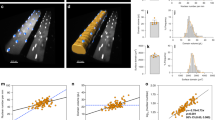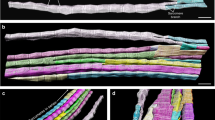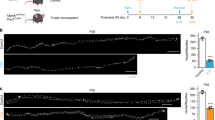Abstract
Differentiating fast and slow mammalian muscles contract slowly at birth and increase their speed during the first few weeks of life1,2. However, only small proportions of slow myosin light chains are found in early developing muscles and the fast type of light chains predominate3–7. In addition, differentiating muscle contains unique, embryonic forms of myosin which may partially determine the early slow responses8–15. The present study suggests additional reasons for these slow twitch times. Most skeletal muscles are initially formed from a small population of primary generation cells16,17 which are innervated by pioneering axons early in myogenesis18. Subsequently, numerous secondary generation cells develop along the walls of primary myotubes, then separate and become independent units of contraction. Using affinity-purified antibodies to fast and slow myosin5, it was found that most primary myotubes react with anti-slow myosin and are destined to become slow, Type I fibres. By contrast, secondary generation cells stain exclusively with anti-fast myosin and develop into Type II, fast fibres. We propose that primary myotubes constitute the fundamental motor units of the developing neuromuscular system and are responsible for early slow movements. Secondary generation cells become organized into large, fast motor units later in development, eclipsing the original slow response.
This is a preview of subscription content, access via your institution
Access options
Subscribe to this journal
Receive 51 print issues and online access
$199.00 per year
only $3.90 per issue
Buy this article
- Purchase on Springer Link
- Instant access to full article PDF
Prices may be subject to local taxes which are calculated during checkout
Similar content being viewed by others
References
Buller, A. J., Eccles, J. & Eccles, R. J. Physiol., Lond. 150, 399–416 (1960).
Close, R. J. Physiol., Lond. 173, 74–95 (1964).
Sréter, F., Holtzer, S., Gergely, J. & Holtzer, H. J. Cell Biol. 55, 586–594 (1972).
Pelloni-Mueller, G., Ermini, M. & Jenny, E. FEES Lett. 67, 68–74 (1976).
Rubinstein, N., Pepe, F. & Holtzer, H. Proc. natn. Acad. Sci. U.S.A. 74, 4524–4527 (1977).
Rubinstein, N. & Kelly, A. Devl Biol. 62, 473–485 (1978).
Syrovy, J. & Gutmann, E. Pflügers Arch. ges. Physiol. 369, 85–89 (1977).
Trayer, I. P., Harris, C. I. & Perry, S. V. Nature 217, 452–453 (1968).
Huszar, G. Nature new Biol. 240, 260–264 (1972).
Sréter, F., Balint, M. & Gergely, J. Devl Biol. 46, 317–325 (1975).
Whalen, R., Butler-Browne, G. & Gros, F. J. molec. Biol. 126, 415–431 (1978).
Whalen, R., Butler-Browne, G., Sell, S. & Gros, F. Biochemie 61, 625–632 (1979).
Whalen, R., Schwartz, K., Bouveret, P., Sell, S. & Gros, F. Proc. natn. Acad. Sci. U.S.A. 76, 5197–5201 (1979).
Hoh, J. & Yeoh, A. P. S. Nature 280, 321–323 (1979).
Rushbrook, J. & Stracher, A. Proc. natn. Acad. Sci. U.S.A. 76, 4331–4334 (1979).
Kelly, A. & Zacks, S. J. Cell Biol. 42, 135–153 (1969).
Church, J. J. Anat. 105, 419–438 (1969).
Bennett, M. & Pettigrew, A. J. Physiol., Lond. 241, 515–545 (1974).
Rowlerson, A. J. Physiol., Lond. 301, 19 (1980).
Rubinstein, N. & Kelly, A. J. Cell Biol. (in the press).
Carlson, B. & Gutmann, E. Expl Neurol. 58, 82–93 (1976).
Ashmore, C., Robinson, D., Rattray, P. & Doerr, L. Expl Neurol. 37, 241–255 (1972).
Kelly, A. & Schotland, D. in Muscle Development and the Muscle Spindle (ed. Banker) (Excerpta Medica, Amsterdam, 1972).
Salmons, S. & Sréter, F. Nature 263, 30–34 (1976).
Salmons, S. & Vrbova, G. J. Physiol., Lond. 210, 535–549 (1969).
East, E. Anat. Rec. 50, 201–212 (1931).
Strauss, S. & Weddell, G. J. Neurophysiol. 3, 358–369 (1940).
Windle, W., Minear, W., Austin, M. & Orr, D. Physiol. Zool 8, 156–185 (1935).
Kelly, A. & Zacks, S. J. Cell Biol. 42, 154–169 (1969).
Kikuchi, T. & Ashmore, C. Cell Tissue Res. 171, 233–251 (1977).
Ontell, M. Anat. Rec. 189, 669–690 (1977).
Setz, W., Caldwell, J. & Ribchester, R. J. Physiol., Lond. 297, 463–478 (1979).
Gauthier, G., Lowey, S. & Hobbs, A. Nature 274, 125–129 (1978).
Kugelberg, E. J. J. Neurol. Sci. 27, 269–289 (1976).
Author information
Authors and Affiliations
Rights and permissions
About this article
Cite this article
Kelly, A., Rubinstein, N. Why are fetal muscles slow?. Nature 288, 266–269 (1980). https://doi.org/10.1038/288266a0
Received:
Accepted:
Issue Date:
DOI: https://doi.org/10.1038/288266a0
This article is cited by
-
Differences between fast and slow muscles in scallops revealed through proteomics and transcriptomics
BMC Genomics (2018)
-
A role for Insulin-like growth factor 2 in specification of the fast skeletal muscle fibre
BMC Developmental Biology (2007)
-
Growth-related alterations in motor endplates of type-identified diaphragm muscle fibres
Journal of Neurocytology (1995)
-
Comparison of the foetal development of fibre types in four bovine muscles
Journal of Muscle Research and Cell Motility (1994)
-
Expression of slow and fast myosin heavy chains in overloaded muscles of the developing rat
Journal of Muscle Research and Cell Motility (1991)
Comments
By submitting a comment you agree to abide by our Terms and Community Guidelines. If you find something abusive or that does not comply with our terms or guidelines please flag it as inappropriate.



